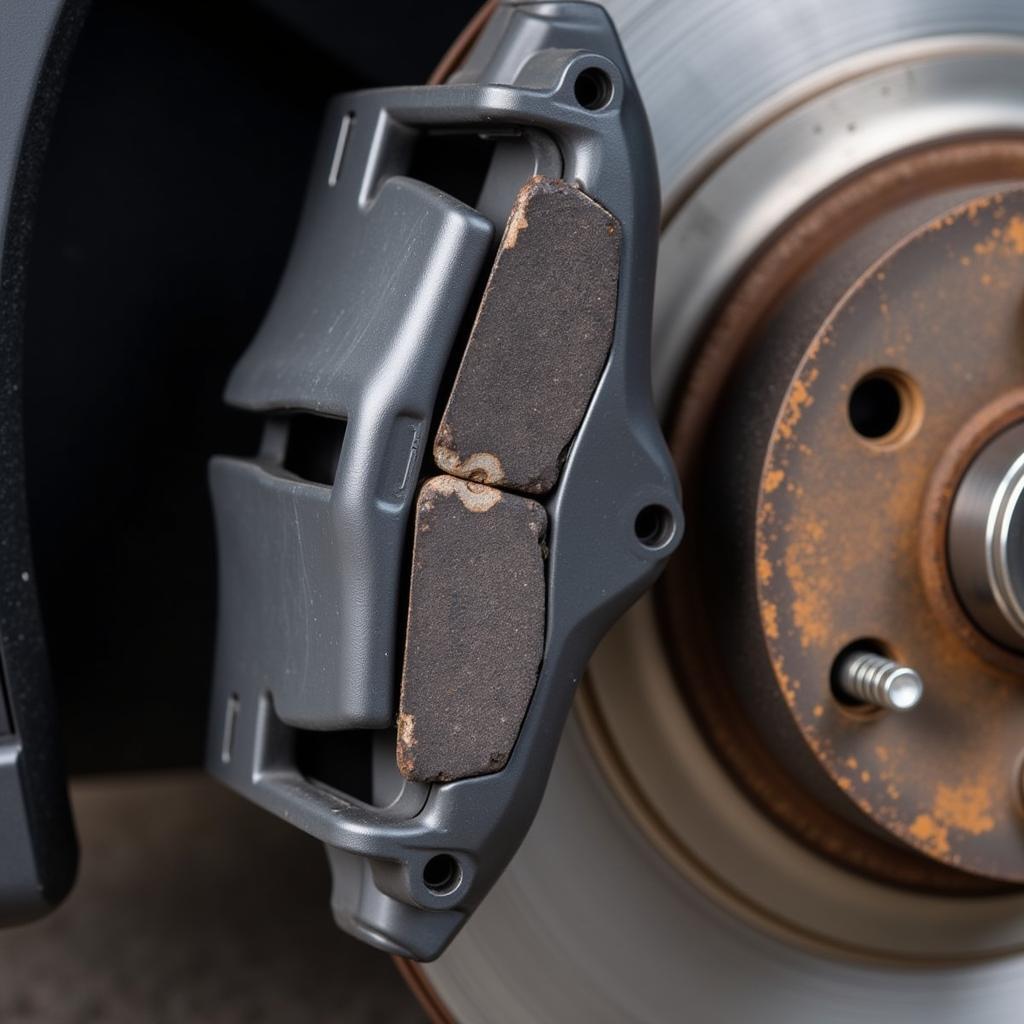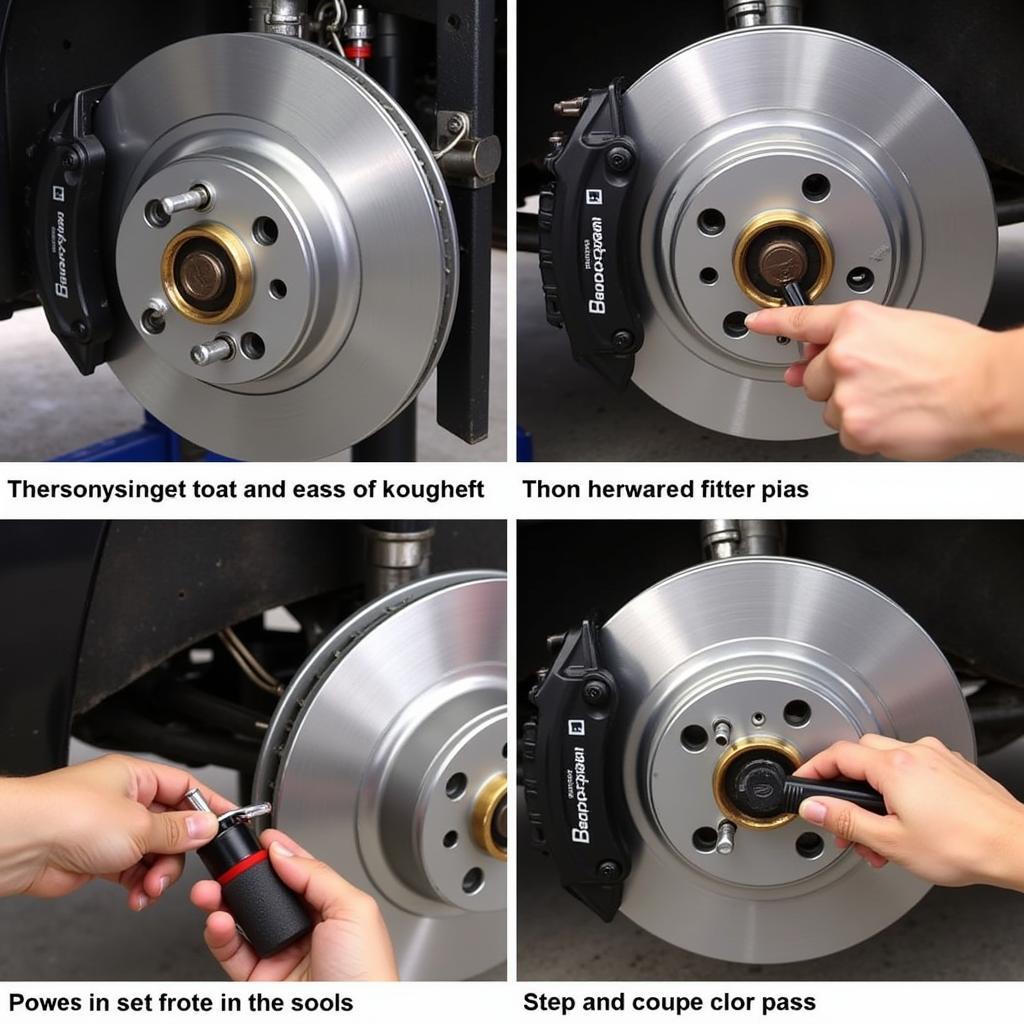The brake pad warning light on your Audi A3 is a crucial safety feature designed to alert you of potential braking system issues. When illuminated, it signals that your brake pads are nearing the end of their lifespan and require immediate attention. Ignoring this warning can lead to decreased braking performance and potentially dangerous driving conditions.
This comprehensive guide will delve into the intricacies of the Audi A3 brake pad warning light, covering its possible causes, troubleshooting steps, and potential solutions. Whether you’re a DIY enthusiast or prefer professional assistance, understanding this essential warning system is vital for maintaining your vehicle’s safety and your peace of mind.
Decoding the Audi A3 Brake Pad Warning Light
The brake pad warning light, typically depicted as a circle with parentheses on either side and a dotted line in between, illuminates on the dashboard when the brake system detects a problem. In most Audi A3 models, this light is amber or yellow, indicating a cautionary warning rather than an immediate emergency. However, its illumination should never be ignored.
Common Causes of an Illuminated Brake Pad Warning Light
While worn brake pads are the most frequent culprit behind the illuminated warning light, other potential causes include:
- Worn Brake Pad Sensor: Most Audi A3s are equipped with brake pad wear sensors, small metal tabs embedded within the brake pad material. As the brake pad wears down, the sensor comes into contact with the brake rotor, completing an electrical circuit and triggering the warning light.
- Low Brake Fluid Level: Brake fluid is the lifeblood of your Audi A3’s braking system, transmitting force from the brake pedal to the wheels. A leak in the system or low brake fluid level can trigger the warning light.
- Faulty Brake Pad Sensor Wiring: Damaged or corroded wiring connecting the brake pad sensors to the vehicle’s electrical system can disrupt the signal, causing a false warning light.
- Issues with the ABS System: While less common, problems within the Anti-lock Braking System (ABS) can also trigger the brake pad warning light. This usually coincides with the illumination of the ABS warning light.
 Audi A3 Brake Pad Sensor
Audi A3 Brake Pad Sensor
Troubleshooting an Audi A3 Brake Pad Warning Light
Before assuming the worst, it’s essential to rule out simple causes. Here are some steps you can take:
- Check Your Brake Fluid Level: Locate the brake fluid reservoir under the hood, typically a translucent container with a clearly marked minimum and maximum level. If the fluid level is below the minimum mark, add the appropriate DOT specification brake fluid recommended in your owner’s manual.
- Inspect Your Brake Pads: If you’re comfortable with basic car maintenance, you can visually inspect your brake pads. Look through the spaces between the wheel spokes to assess the thickness of the brake pad material. If it appears significantly thin or you see the wear indicator making contact with the rotor, replacement is likely necessary.
- Consult Your Audi A3 Owner’s Manual: Your owner’s manual is a treasure trove of information, providing specific details about your car’s warning lights and recommended maintenance schedules.
When to Seek Professional Help
If the brake pad warning light remains illuminated after checking your brake fluid and visually inspecting your brake pads, it’s crucial to seek professional assistance.
 Audi A3 Brake Pad Replacement
Audi A3 Brake Pad Replacement
The Importance of Timely Brake Pad Replacement
Neglecting worn brake pads can have serious consequences:
- Reduced Braking Performance: Worn brake pads provide less friction material for stopping, significantly increasing your stopping distance.
- Damage to Brake Rotors: Driving with worn pads can damage the brake rotors, leading to costly repairs.
- Compromised Safety: Worn brake pads can ultimately lead to brake failure, putting you and others on the road at risk.
Preventive Measures for Optimal Brake Pad Lifespan
Extending the life of your brake pads not only saves you money but also ensures optimal braking performance:
- Smooth Braking: Avoid hard braking whenever possible. Gradual braking reduces wear and tear on your brake pads.
- Maintain a Safe Following Distance: A safe following distance gives you ample time to brake smoothly, reducing stress on your brakes.
- Regular Brake Inspections: Adhering to your Audi A3’s recommended maintenance schedule, which includes regular brake inspections, can help identify potential issues before they escalate.
2011 subaru legacy brake warning light
Remote Diagnostic and Programming Solutions for Your Audi A3
In today’s technologically advanced world, remote diagnostic and programming services offer a convenient and efficient way to address certain automotive issues, including those related to your Audi A3’s braking system.
1995 subaru legacy wagon brake warning light stays on
These services leverage advanced telematics and software to diagnose problems, provide software updates, and even resolve certain issues remotely, reducing the need for physical visits to a repair shop.
2007 subaru legacy brake warning lamp lights up
However, it’s important to note that not all braking system problems can be resolved remotely, and a professional inspection is often necessary to ensure the safety and reliability of your vehicle.
2014 subaru legacy red brake warning light flashing
Conclusion
The brake pad warning light on your Audi A3 serves as an early warning system, alerting you to potential issues with your braking system.
Understanding the common causes behind this warning light, coupled with prompt action, ensures your safety on the road and prolongs the lifespan of your Audi A3’s braking components. Remember, regular maintenance and timely repairs are essential investments in your safety and the longevity of your vehicle.


